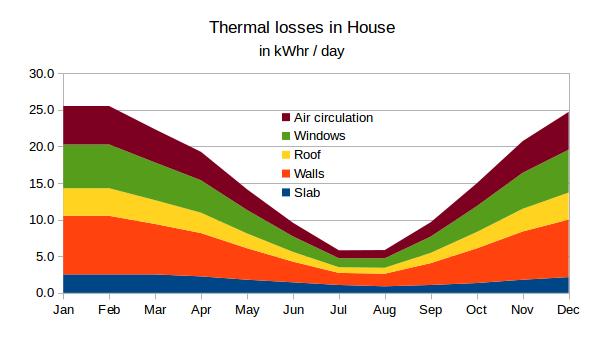Update on Energy Use Based on 4 years of Actuals
As I have discussed on earlier podcasts and various topics, I have a Willis-based configuration for heating our low energy house, and control is implemented with a dedicated Raspberry Pi using a custom NodeRED application for our underfloor heating and SunAMP-based hot water. This system logs a lot of instrumentation temperatures every half hour and also any significant events such as turning on and off pumps and the heater.
Our electricity supplier has been OVO for the last 4 years, and because we have a smart meter, the control application also includes a script to log on to the OVO Portal and download the daily usage data into the MySQL database.
Because these latest energy hikes, we have decided to revisit the issue of whether it would now be cost-effective to install an ASHP in order to save on monthly electricity costs for heating. Because I have been logging all relevant data for the past 4 years, I can base this decision on hard actuals rather than some generic planning assumptions. The next two graphs summarise these results. The first is an analysis of our daily energy use (we have an electricity only house). What I have done here is to aggregate the 4 years of data by calendar month and split these into three categories:
-
Underfloor Heating (34% or ~4,000 kWh/yr). In practice, we only heat off-peak and use the thermal mass of the floor slab and the house itself to smooth out the overall background heat levels. As I have discussed in other topics, this results in a temperature ripple of about 1°C which is quite acceptable given the reduction in overall all heating costs.
-
Other Off-peak use (25% or ~2,900 kWh/yr). We also use a couple of small oil-filled electric heaters on the first and second floors for the 4 cold winter months. These output roughly 1 kWh and run on a timer (actually controlled by my home automation system). We find that 3 or 4 hours is typically enough to keep the upstairs acceptably warm in the coldest month; this also means that the UFH on-time doesn't need to run over into peak periods. Our resistive load white goods (the washing machine, dishwasher, SunAmp DHW) are timed to come on in the off-peak period.
- General Peak Rate use (39% or ~4,500 kWh/yr). Pretty much all of our baseload and direct hands-on devices: fridges, freezers, cooking, computers lighting, etc.
Note that the 2 retired (out of the 3) occupants of the house spend most of May, June, September, October abroad; hence the dip in this general use figure. I find the annual variation on this base load a little intriguing ,and I am not sure why it is so high. Our live-in son often has his radiator on in the evenings when he's at home, and we do spend more time indoors in the cold dark months.
The simplest ASHP implementation would be for slab heating only and would give a CoP of ~4 (as the circulation temperature is under 35°C) hence saving perhaps 3 mWh p.a. @ 18.86p/kWh or roughly ~£560 p.a. at our currently quoted OVO night rate. Given that we would need to use an MCS certified installer to exploit a permitted development waiver, I would expect our installation to be £10K or higher, so I still don't have a viable cost benefit case to go this route. Yes, adding pre-heat for the SunAmps would increase this annual saving, but this would complicate the installation, and given our volume of DHW use this would in fact worsen the cost benefit case rather than improve it.
Another interesting point is raised by the following graph which I pulled from a 2014 Thermal Design post. The bottom line is that thanks to entropy, pretty much all of the electrical energy that we use ultimately ends up as heat within the fabric and airspace of the house. Given this, the overall heat losses (if you take December for example) are pretty much double what we originally estimated. The following can account for the majority of variance, but not all.
- We had to drop the U-value for the warm roof to minimise ridgeline heights keep the planners happy
- We added 60° reveals to our fenestration to improve overall light levels given the planners putting hard limits on our window sizes, and these some limited thermal bridging
- Winter solar gain is almost non-existent for our window configurations.
- As discussed in an earlier post, we had a cock-up in our slab design which created a thermal bridge between the inner ring beam (this supports the frame) and the outer ring beam (supporting the stone skin). We could only partially mitigate this during slab pour.
- We estimated that MVHR would have a recovery efficiency of around 90%, but looking at the inlet temp vs room, I estimate the actual recovery is nearer to 80%, that is double the heat loss.
- We run the internal room temperatures a couple of degrees warmer than initially planned.
However the house is built and well established so getting any convergence is now unlikely. So the house performs as a low-energy one, rather than a true zero-energy one. And we still only put ~20kWh into our slab in the coldest months.

Edited by TerryE
-
 9
9


.png.9fddf57172b5a236322dcf8b13a2ce2d.png)
.png.c948d863703e26666b779eee417d10c0.png)
26 Comments
Recommended Comments
Create an account or sign in to comment
You need to be a member in order to leave a comment
Create an account
Sign up for a new account in our community. It's easy!
Register a new accountSign in
Already have an account? Sign in here.
Sign In Now